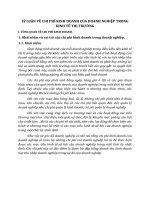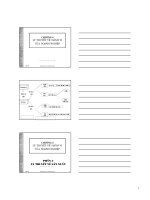bài giảng hành vi của doanh nghiệp - ĐH kinh tế
Bạn đang xem bản rút gọn của tài liệu. Xem và tải ngay bản đầy đủ của tài liệu tại đây (8.06 MB, 50 trang )
Bài 5: Hành vi của
doanh nghiệp
I. Chi phí sản xuất
The Costs of Production
The Law of Supply:
◆ Firms are willing to produce and sell a
greater quantity of a good when the price
of the good is high.
◆ This results in a supply curve that slopes
upward.
Luật cung:
◆ Các doanh nghiệp muốn sản xuất
và bán một lượng hàng hoá nhiều
hơn khi giá cả cao.
◆ Kết quả là đường cung hướng lên.
The Firm’s Objective
The economic goal of the firm is to
maximize profits.
A Firm’s Total Revenue and Total
Cost
◆ Total Revenue
◆
The amount that the firm receives for the
sale of its output.
◆ Total
◆
The amount that the firm pays to buy
inputs.
◆ Tổng
◆
doanh thu
Lượng tiền doanh nghiệp nhận được từ
việc bán sản phẩm của mình.
◆ Tổng
◆
Cost
chi phí
Lượng tiền mà doanh nghiệp phải trả để
mua các đầu vào.
A Firm’s Profit
Profit is the firm’s total revenue minus
its total cost.
Profit = Total revenue - Total cost
Chi phí tính bằng chi phí cơ hội
Costs as Opportunity Costs
A firm’s cost of production
includes all the opportunity costs
of making its output of goods
and services.
Chi phí sản xuất của doanh
nghiệp bao gồm toàn bộ chi phí
cơ hội phát sinh trong quá trình
sản xuất ra sản lượng hàng hoá
và dòch vụ.
Explicit and Implicit Costs
Chi phí ẩn và chi phí hiện
A firm’s cost of production include
explicit costs and implicit costs.
◆ Explicit
costs involve a direct money outlay
for factors of production.
◆ Implicit costs do not involve a direct money
outlay.
Chi phí sản xuất của doanh nghiệp bao
gồm chi phí ẩn và chi phí hiện.
◆ Chi phí hiện đề cập đến kinh phí
trực tiếp trả cho các yếu tố sản xuất.
◆ Chi phí ẩn không liên quan với kinh
phí trực tiếp.
Economic Profit versus
Accounting Profit
Economists measure a firm’s economic profit
as total revenue minus all the opportunity
costs (explicit and implicit).
◆ Accountants measure the accounting profit as
the firm’s total revenue minus only the firm’s
explicit costs. In other words, they ignore the
implicit costs.
◆ Nhà kinh tế tính lợi nhuận kinh tế của doanh
nghiệp bằng cách lấy tổng doanh thu của
doanh nghiệp trừ tổng tất cả các chi phí cơ
hội (bao gồm chi phí ẩn và chi phí hiện).
◆ Nhà kế toán tính lợi nhuận kế toán của doanh
nghiệp bằng cách lấy tổng doanh thu của
doanh nghiệp trừ các khoản chi phí hiện của
nó.
◆
Economic Profit versus
Accounting Profit
◆ When total revenue exceeds both
explicit and implicit costs, the firm
earns economic profit.
◆ Economic profit is smaller than
accounting profit.
◆ Khi tổng doanh thu vượt quá cả chi
phí ẩn và chi phí hiện, thì nhà doanh
nghiệp kiếm được một khoản lợi
nhuận kinh tế.
◆ Lợi nhuận kinh tế thì nhỏ hơn lợi
nhuận kế toán.
Economic Profit versus
Accounting Profit
How an Economist
Views a Firm
How an Accountant
Views a Firm
Economic
profit
Accounting
profit
Revenue
Implicit
costs
Explicit
costs
Revenue
Total
opportunity
costs
Explicit
costs
A Production Function and
Total Cost
Number of
Workers
Output
0
0
1
50
2
Marginal
Product of
Labor
Cost of
Factory
Cost of
Workers
Total Cost of
Inputs
$30
$0
$30
50
30
10
40
90
40
30
20
50
3
120
30
30
30
60
4
140
20
30
40
70
5
150
10
30
50
80
The Production Function
Hàm sản xuất
The production function shows
the relationship between
quantity of inputs used to make
a good and the quantity of
output of that good.
Hàm sản xuất là mối quan hệ
giữa lượng đầu vào đựơc sử
dụng để tạo ra hàng hoá và sản
lượng hàng hoá.
Sản phẩm biên
Marginal Product
The marginal product of any
input in the production process is
the increase in the quantity of
output obtained from an
additional unit of that input.
Sản phẩm cận biên của của bất
kỳ đầu vào nào trong quá trình
sản xuất cũng bằng mức tăng
sản lượng thu đựơc từ một đơn vò
tăng thêm của đầu vào đó.
Marginal Product
Saỷn phaồm caọn bieõn
Marginal =
product
Additional output
Additional input
Sản phẩm cận biên giảm dần
Diminishing Marginal Product
Diminishing marginal product
◆ Example: As more and more workers are
hired at a firm, each additional worker
contributes less and less to production
because the firm has a limited amount of
equipment.
◆ Sản phẩm biên giảm dần
◆ Ví dụ: ngày càng nhiều công nhân được
thuê, mỗi công nhân tăng thêm đóng góp
càng ít hơn vào việc sản xuất do doanh
nghiệp có số lượng trang thiết bòù giới hạn.
◆
A Production Function...
Quantity of
Output
(cookies
per hour)
150
140
130
120
110
100
90
80
70
60
50
40
30
20
10
0
Production function
1
2
3
4
5 Number of Workers Hired
Từ hàm sản xuất đến đường tổng chi phí
From the Production Function to the
Total-Cost Curve
The relationship between the quantity a
firm can produce and its costs
determines pricing decisions.
◆ The total-cost curve shows this
relationship graphically.
◆
Mối quan hệ giữa số lượng mà doanh
nghiệp có thể sản xuất và chi phí để
đònh giá.
◆ Đường tổng chi phí thể hiện mối quan
hệ này trên đồ thò.
◆
A Production Function and
Total Cost
Number of
Workers
Output
0
0
1
50
2
Marginal
Product of
Labor
Cost of
Factory
Cost of
Workers
Total Cost of
Inputs
$30
$0
$30
50
30
10
40
90
40
30
20
50
3
120
30
30
30
60
4
140
20
30
40
70
5
150
10
30
50
80
Hungry Helen’s Cookie Factory
Total-Cost Curve...
Total
Cost
Total-cost
curve
$80
70
60
50
40
30
20
10
0
20
40
60
80
100 120 140
Quantity of Output
(cookies per hour)
Nhiều đại lượng khác nhau về chi phí
The Various Measures of Cost
Costs of production may be
divided into fixed costs and
variable costs.
Chi phí sản xuất có thể đựơc chia
thành chi phí biến đổi và chi phí
cố đònh.
Fixed and Variable Costs
Chi phí coá ñònh vaø chi phí bieán ñoåi
◆ Total
Fixed Costs (TFC)
◆ Total Variable Costs (TVC)
◆ Total Costs (TC)
TC = TFC + TVC
Family of Total Costs
Quantity
0
1
2
3
4
5
6
7
8
9
10
Total Cost
Fixed Cost
$ 3.00
3.30
3.80
4.50
5.40
6.50
7.80
9.30
11.00
12.90
15.00
$3.00
3.00
3.00
3.00
3.00
3.00
3.00
3.00
3.00
3.00
3.00
Variable Cost
$ 0.00
0.30
0.80
1.50
2.40
3.50
4.80
6.30
8.00
9.90
12.00
Chi phí bình quân
Average Costs
◆ Average
costs can be determined
by dividing the firm’s costs by the
quantity of output produced.
◆ The average cost is the cost of
each typical unit of product.
◆ Chi
phí bình quân được xác đònh
bằng cách lấy chi phí của doanh
nghiệp chia cho sản lượng mà nó
sản xuất ra.
◆ Chi phí bình quân là chi phí của
mỗi đơn vò sản phẩm điển hình.
Family of Average Costs
◆ Average
Fixed Costs (AFC)
◆ Average Variable Costs (AVC)
◆ Average Total Costs (ATC)
ATC = AFC + AVC
Family of Average Costs
Fixed cost FC
AFC =
=
Quantity
Q
Variable cost VC
AVC =
=
Quantity
Q
Total cost TC
ATC =
=
Quantity
Q









